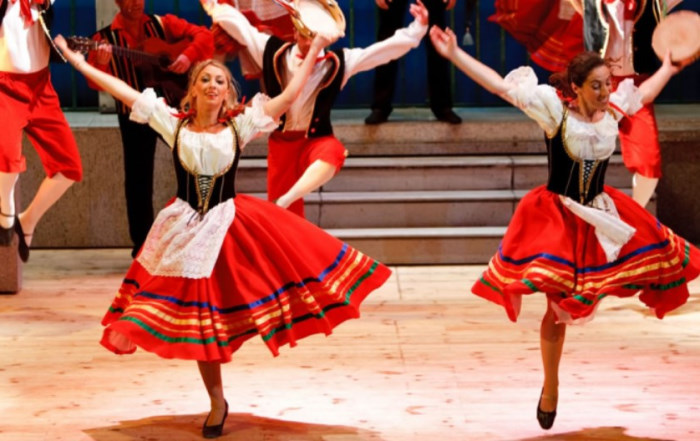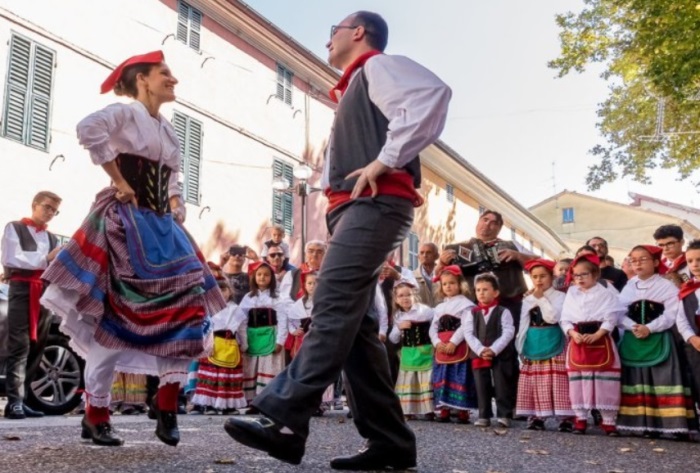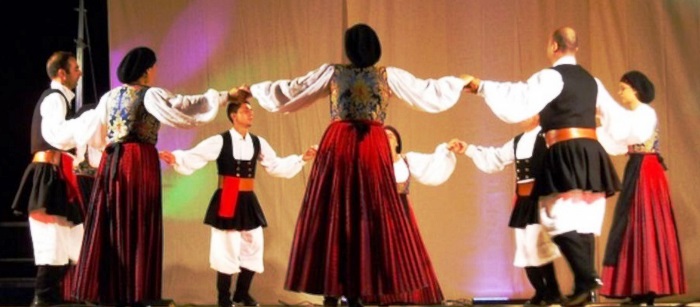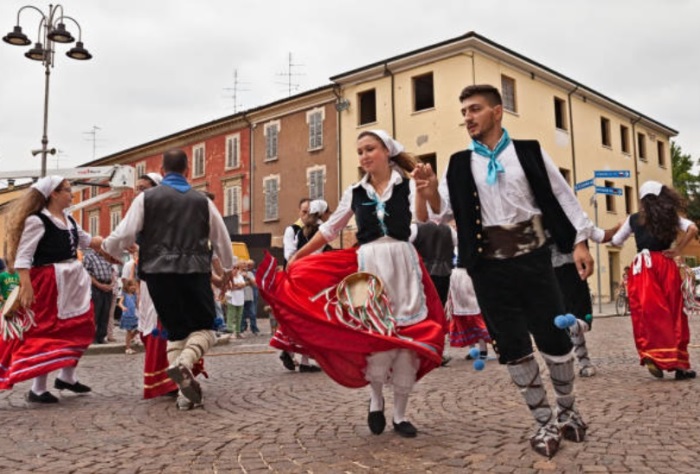Ever since the Roman empire, Italian culture has always been a powerhouse in the Old Continent, especially with the initiation of the Renaissance.
Through traditional Italian dances, we delve into a crucial part of the country’s history and learn the fascinating events behind folk dances that seem to be purely recreational at first sight.
Table of Contents
7 Popular Traditional Italian Dances
Tarantella – The Most Popular Traditional Italian Dance

If you ask around, most people would agree that Tarantella is the most famous dance in Italy regarding both traditional and folk aspects. Its earliest record goes back to the 15th century, in southern Italy.
The name and the meaning of Tarantella are quite peculiar and intriguing. It is derived from tarantism, a condition caused by a tarantula – a spider, and triggers seizures and crazed behavior in the victim.
According to the myth, the victim called tarantata would be delirious and completely taken over by convulsive dancing.
Musicians needed to play a type of music called pizzica (referring to “bite”) to accompany the tarantata and eliminate the spider’s venom while townspeople surrounded and even participated in the dance.
Looking back at the social situation of the time, scholars believed Tarantella served as an outlet for women of low status to express the strongest emotions they had without being judged or invalidated.
In modern times, the dance of spiders has become a dance for couples to flirt, and we now associate it with joyful occasions like weddings.
Many groups of contemporary artists perform the dance within the country and abroad, further spreading its influence.
Pizzica
Related to the pizzica music mentioned above and the Tarantella branch, the Pizzica dance is a folk dance spread from Salento to the entire Apulia, Calabria, and East Basilicata regions.
Traditionally, people use the Pizzica dance to save someone bitten by a spider or metaphorically possessed by evil spirits.
However, it eventually evolved and varied greatly from Tarantella because it is performed by a duo, often but not mandatorily a male-female couple.
While it is possible to find two women dancing to Pizzica, we rarely see two men going for it in the present, unless one of them playfully imitates a woman or both pull off a duel act.
Nowadays, you can witness the original Pizzica in La Notte della Taranta, a festival celebrated every August in Grecia Salentina, South Lecce, and West Otranto.
Artists from all over the world are welcome to create colorful and exciting parties and concerts.
Saltarello

We get a clear definition of Saltarello, which is a derivation of saltare (to jump). As the name indicates, the core of this dance is a unique style of jumping steps. Dancers are required to maintain great balance on one foot most of the time.
The records for Saltarello began in the 14th century and noted it as a court dance. It was considered a dance of improvisation and was always recognized by the fast jumps.
A couple of centuries later, it joined masquerades and became an essential movement in the Renaissance dance era.
By the next century, Saltarello mingled with the folk traditions, recorded as the most popular dance in Rome, specifically the Monte Testaccio’s vintage festivals. The performers are in pairs but not limited by their gender.
Saltarello is described as a declaration of love. With refined movements, the performers visualize various moods in love: hopeful, passionate, and even jealous.
Thanks to the local dancers, the young generations are not foreign to Saltarello at all. You can see it for yourself at the summer festivities of the aforementioned regions.
Ballu Tundu
Also known as Ballu Sardu, it is a “round” dance, characterized by its format as an open or closed circle. The oldest records point to the beginning of the 19th century by Mameli and La Marmora.
The singers will stand in the center of the circle and the dancers will perform lively movements and leaps around them. Dancers should hold hands, yet there are some strict rules to follow.
If two of them are a couple, they can interlace fingers and press their palms together as they wish, though a man isn’t allowed to do the same to a married woman or a female stranger.
Aside from the hand-holding rules, the nature of the dance is very carefree and joyful.
At parties, Ballu Tundu is not only a means for people to relieve stress from daily life, but also a chance for men and women to meet up, date, and maybe even fall in love.
We have a higher chance to watch this dance around College Square or the churches of Santa Maria and San Lussorio at marriages, births, and other positive gatherings. The locals tend to have great admiration for Ballu Tundu dancers.
Furlana
At the end of the 17th and the beginning of the 18th centuries, Furlana was arguably the most famous dance in Italy and the entire Europe as well. It originated in Friuli, between Venice and Trieste.
The documents described Furlana as a courtship dance by couples, hence it was generally labeled as a social dance with a good number of appearances in theatrical pieces.
Much unexpectedly, Furlana suffered a decline in popularity as the 18th century went by. You could count the operas involving Furlana with one hand – people barely cared about it, so knowing how to do it was too far from reality.
Somehow, before the Great War came to an end, Furlana suddenly made a comeback, although the dance craze only lasted for a few months.
At one point, it was even more popular than Tango, and every name in the field of dancing tried to concoct an authentic Furlana.
Having only the tambourine as the original instrument and not being danced for decades, it was hard to tell if the creations they had were close to the classic Furlana.
Monferrina
When it comes to liveliness, there are hardly any dances surpassing Monferrina. It was named after where it originally came from, which is Montferrat, Piedmont. Its influence took over North Italy and reached foreign territories.
English people called it a country dance and danced to it quite frequently during the end of the 18th century. It even appeared in Country Dances in 1810 under the names Manfredina, Monfrina, and Monfreda.
Back in its hometown Piedmont, the performance includes a few couples and starts with two promenades.
The dancers will be arm-in-arm and then join hands with their partners while executing lively marching and cross-stepping while bending their knees.
The mimed coaxing and teasing give the atmosphere an extremely lighthearted and friendly touch. So, Monferrina has always been great as a social dance, especially for young men and women looking for a relaxing time.
Tammurriata
Once again, Tarantella appears on this list, or its southern variation, to be precise. Nonetheless, this Campania folk dance has a different and much too old origin.
Tammurriata is immensely tied to the Greek world and considered a blessing from the gods. Through this dance, immortals believe they can take one step closer to divinity.
Another perspective on the meaning of Tammurriata connects the dance to the Seven Madonna’s cult, resulting in various versions with different messages delivered, ranging from fight to courtship.
Tammurriata performers will be put in pairs and form a circle while the musicians, singers, and spectators do the same. Inspired by field labor or house chores, their movements are deeply symbolic.
Check more: 10 Best Traditional African Dances To Watch
Where To See Traditional Italian Dances?
The chances to see these lively Italian dances are not rare, even if we put the internet method out of the picture!
For me, there is no better way to enjoy a folk dance than by attending the festival it stands for.
If you are visiting a certain region, you might want to turn it into a cultural journey and see a live performance. It will also be a great opportunity to get yourself familiar with the nation’s customs and heritage.
Another more economical and convenient way would be to look up local community centers and dance schools related to Italian culture. They are very likely to have a mini version of those grand festivities and the dance performances are included.
Final Words
Italy has an amazingly rich historical heritage with significant and famed cultural traits, and these traditional Italian dances contribute remarkably to the value of its history.
More than a form of art, they are stories from the past and adventures against the current of time. By learning them, you will earn yourself new dance skills as well as more knowledge!

